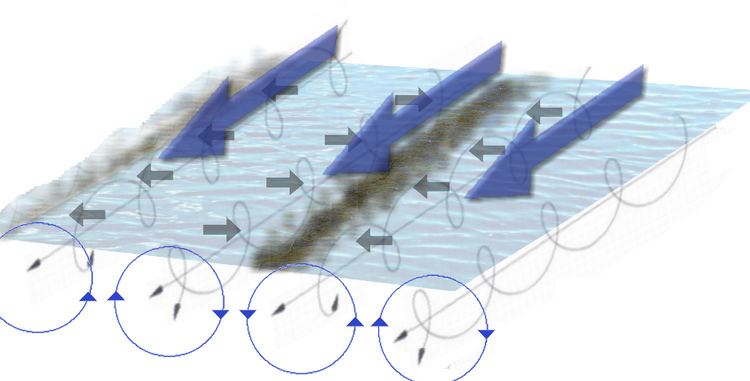 | ||
In physical oceanography, Langmuir circulation consists of a series of shallow, slow, counter-rotating vortices at the ocean's surface aligned with the wind. These circulations are developed when wind blows steadily over the sea surface. Irving Langmuir discovered this phenomenon after observing windrows of seaweed in the Sargasso Sea in 1927. Langmuir circulations circulate within the mixed layer; however, it is not yet so clear how strongly they can cause mixing at the base of the mixed layer.
Contents
Theory
The driving force of these circulations is an interaction of the mean flow with wave averaged flows of the surface waves. Stokes drift velocity of the waves stretches and tilts the vorticity of the flow near the surface. The production of vorticity in the upper ocean is balanced by downward (often turbulent) diffusion
where the first definition is for a monochromatic wave field of amplitude
where
In the open ocean conditions where there may not be a dominant length scale controlling the scale of the Langmuir cells the concept of Langmuir Turbulence is advanced.
Observations
The circulation has been observed to be between 0°–20° to the right of the wind in the northern hemisphere and the helix forming bands of divergence and convergence at the surface. At the convergence zones, there are commonly concentrations of floating seaweed, foam and debris along these bands. Along these divergent zones, the ocean surface is typically clear of debris since diverging currents force material out of this zone and into adjacent converging zones. At the surface the circulation will set a current from the divergence zone to the convergence zone and the spacing between these zones are of the order of 1–300 m (3–1,000 ft). Below convergence zones narrow jets of downward flow form and the magnitude of the current will be comparable to the horizontal flow. The downward propagation will typically be in the order of meters or tenths of meters and will not penetrate the pycnocline. The upwelling is less intense and takes place over a wider band under the divergence zone. In wind speeds ranging from 2–12 m/s (6.6–39.4 ft/s) the maximum vertical velocity ranged from 2–10 cm/s (0.79–3.94 in/s) with a ratio of down-welling to wind velocities ranging from −0.0025 to −0.0085.
